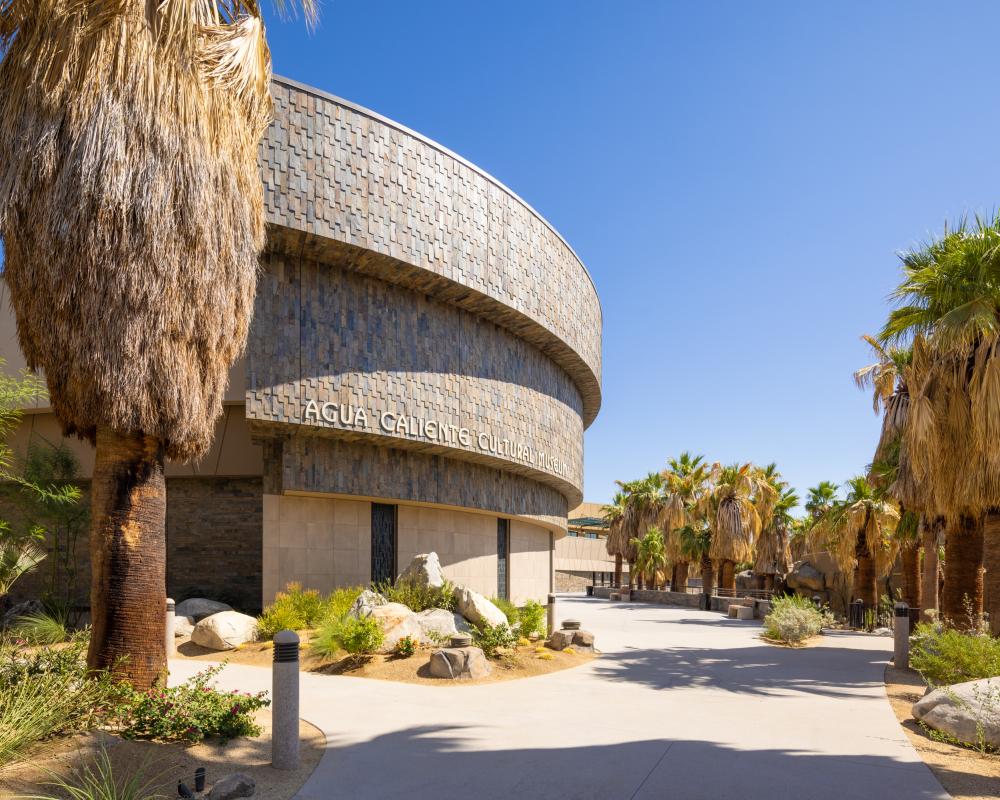How the Agua Caliente Tribe’s All-Woman Council Changed Palm Springs Forever
Palm Springs has long been a city ahead of its time, famed for its bold architecture, vibrant culture, and progressive spirit. But one of the most groundbreaking moments in its history came in 1954, when the Agua Caliente Band of Cahuilla Indians made national headlines by forming what is believed to be the first all-woman Tribal Council in the United States.
This was the same era as Mad Men—a time when women were more likely to be seen as secretaries than decision-makers. But in Palm Springs, five visionary Native American women took the reins of leadership and made history, not just for their tribe, but for Native communities nationwide.
The Fabulous Five: Tribal Women Who Changed the Game
The newly elected Agua Caliente Tribal Council of 1954 was led by Chairman Vyola J. Ortner, with council members LaVerne Saubel, Eileen Miguel, Elizabeth Pete Monk, and Flora Patencio (who was succeeded by Gloria Welmas Gillette after resigning six months into the term). These trailblazing women shattered gender and cultural barriers at a time when female leadership was rare, especially within tribal governance.
Together, they enacted sweeping changes that forever altered the trajectory of Palm Springs and the future of tribal sovereignty.
Vyola J. Ortner – Chairman and Trailblazer
As Tribal Council Chairman, Vyola Ortner led with vision, tenacity, and diplomacy. She was the driving force behind the push for 99-year leases, personally lobbying Congress and federal officials in Washington, D.C., and Sacramento. Ortner’s work was instrumental in the passage of the General Leasing Act of 1959, a landmark law that reshaped tribal economic rights nationwide. She was also a co-author of the Tribe’s first Constitution and By-laws in 1955. Known for her quiet strength and political savvy, Ortner is remembered as one of the most influential Indigenous leaders in modern California history.
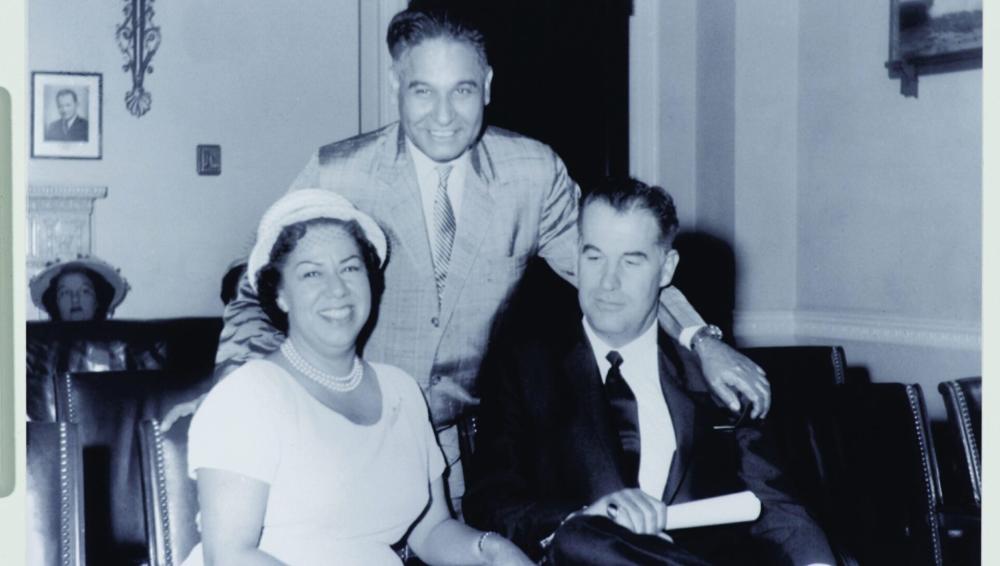
Vyola Ortner in Washington, D.C., with Frank Bogert and Congressman D.S. Saund. Photo by Palm Springs Historical Society.
LaVerne Saubel – Cultural Keeper and Community Leader
LaVerne Saubel was deeply committed to preserving Cahuilla traditions and language. She came from a well-known Agua Caliente family and was an advocate for tribal education and cultural awareness. Later in life, she helped support the early work of the Agua Caliente Cultural Museum and was a trusted resource for local historians and anthropologists. Saubel helped ensure that the Tribe’s cultural identity remained at the heart of its governance and progress.
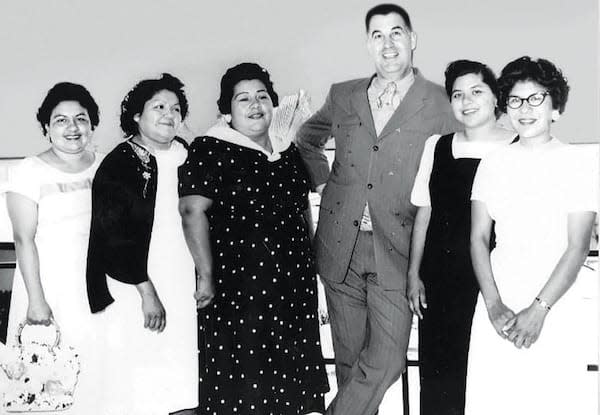
Eileen Miguel, Elizabeth Pete Monk, LaVerne Saubel, Palm Springs Mayor Frank Bogert, Dora Joyce Prieto, and Priscilla Gonzales.
Eileen Miguel – Consensus Builder and Voice for the People
Eileen Miguel was known for her thoughtful leadership and ability to bring people together. As a council member, she played a key role in shaping the policies that guided the Tribe’s early ventures into leasing and business partnerships. She firmly believed in accountability and keeping the community informed about Council actions. Her calm demeanor and clear-headed approach made her a respected figure during a period of significant transition.
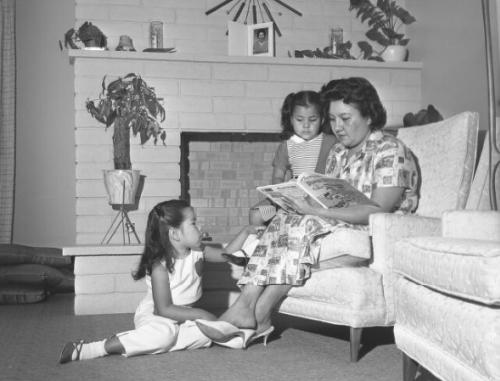
Elizabeth Pete Monk – Strategist and Visionary
Elizabeth Pete Monk brought a sharp intellect and strategic perspective to the Council. She had a firm grasp of the economic potential of the Tribe’s land and supported the Council’s focus on long-term planning. Monk was also active in working with local government officials, helping to build partnerships that benefited both the Tribe and the City of Palm Springs. Her influence helped shape the early business ventures that became models for future development.
Gloria Welmas Gillette – Young Voice, Fresh Perspective
Gloria Welmas Gillette joined the Council in 1954, following Flora Patencio's resignation six months into the term. Though younger than some of her fellow council members, Gillette brought new energy and fresh ideas to the table. She was passionate about education and saw the Council as an opportunity to expand opportunities for future generations. Her involvement demonstrated the Tribe’s commitment to mentoring younger voices and building a multigenerational leadership model.
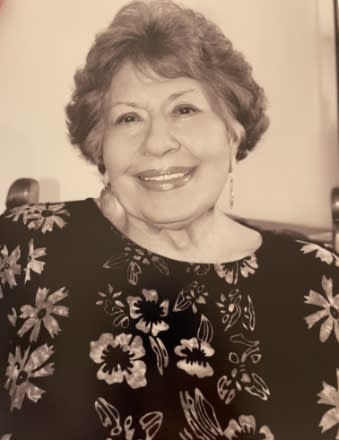
Flora Patencio – Matriarch and Founding Council Member
Flora Patencio was one of the five women elected to the Agua Caliente Tribal Council in 1954, helping to form what would become the first all-woman Tribal Council in U.S. history. A respected elder and matriarch within the Tribe, Patencio came from a family with deep roots in Cahuilla leadership—her relatives had served as ceremonial leaders and cultural knowledge keepers for generations.
Although she resigned from her Council position six months into the term, Patencio’s presence in the original slate of elected leaders helped set the tone for a powerful new era of self-governance. Her wisdom, influence, and commitment to tribal traditions were deeply felt during those early months of transformation, and she remains a part of the legacy that shaped the modern future of the Agua Caliente Band.
Timeline of Transformation: How the Agua Caliente Tribal Council Reshaped Palm Springs
The story of the Agua Caliente Band of Cahuilla Indians and their rise to economic and political power is one of vision, courage, and determination, sparked by the groundbreaking election of an all-woman Tribal Council in 1954. Their leadership transformed Palm Springs, influenced national policy, and continues to shape the Tribe’s legacy today.
1954: A Bold Beginning — The First All-Woman Tribal Council.
Their election made headlines, breaking barriers for both women and Native American leaders during an era when few held positions of power. But their mission was more than symbolic—they had bold plans for the future of their people and their land.
1955: Laying the Legal Foundation
Just one year into their leadership, the Council drafted and ratified the first-ever Constitution and By-laws of the Agua Caliente Band of Cahuilla Indians. This pivotal document established the Tribe’s formal governance system, enabling greater sovereignty, self-determination, and eligibility for federal recognition and partnerships.
The Constitution served as the legal framework that allowed the Council to begin negotiating on behalf of the Tribe, guiding the development of laws, land use, and government-to-government relations that would shape their future.
1956–1958: Fighting for Long-Term Leasing Rights
Realizing that the Tribe's trust lands were restricted to short-term, 25-year leases under federal law, the Council knew long-term economic growth would be impossible without change. Chairman Vyola Ortner took on the challenge, traveling to Washington, D.C., and Sacramento, where she tirelessly lobbied members of Congress and federal agencies.
Her goal was ambitious: to secure 99-year leases on Agua Caliente land, allowing the Tribe to attract investors, build infrastructure, and secure the kind of economic future that had long been out of reach for most Native communities.
1959: A National Breakthrough — The General Leasing Act
Ortner’s advocacy paid off. In 1959, Congress passed the General Leasing Act, which was signed into law by President Dwight D. Eisenhower. The legislation allowed tribes to enter into long-term leases—up to 99 years—for the first time in U.S. history.
Agua Caliente lands were the first to benefit, marking a turning point not only for the Tribe but also for tribal sovereignty and economic development nationwide. What had started as a local initiative in Palm Springs became a national model for empowering Native American communities.
1960–1963: Building a Destination — The Palm Springs Spa Hotel
With the new leasing authority in place, the Council moved quickly to bring investment to downtown Palm Springs. In 1960, they began planning the Palm Springs Spa Hotel, a luxury resort situated at Sec-he, the Tribe’s sacred hot mineral spring.
Designed by midcentury modern architect Donald Wexler, the Spa Hotel blended Indigenous heritage with cutting-edge style. When it opened in 1963, it attracted travelers from around the world, solidifying Palm Springs as a glamorous desert getaway.
More importantly, it demonstrated the potential of tribally led commercial development, inspiring similar projects across Indian Country.
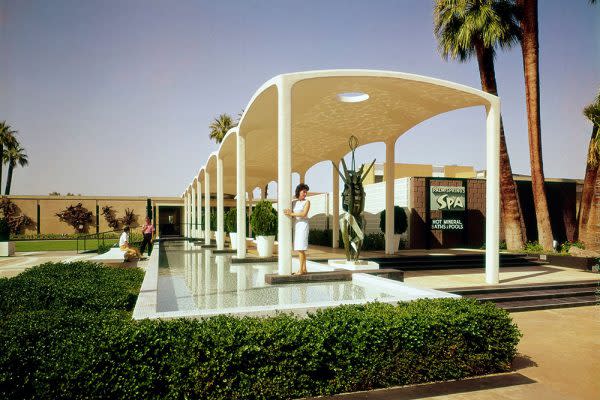
1960s–1970s: Expanding Economic and Political Power
Following the success of the Spa Hotel, the Tribe began leveraging its new leasing authority to spur further growth. Lease agreements permitted the development of new housing, hotels, restaurants, and shopping centers on Agua Caliente land. The Tribe began to collect revenues, invest in its future, and plan for the long term.
The checkerboard pattern of tribal and non-tribal land in Palm Springs—created decades earlier by federal policy—was now an asset. The Tribe held key parcels throughout downtown, which helped fuel urban revitalization while asserting tribal control over development.
Other tribes across the country looked to Agua Caliente as a leader in self-determination and governance.
1980s–2000s: A New Era of Growth
In the following decades, the Agua Caliente Band expanded into new sectors. It first expanded by adding a casino to the Palm Springs Resorts Spa, which was later expanded to what it is today.
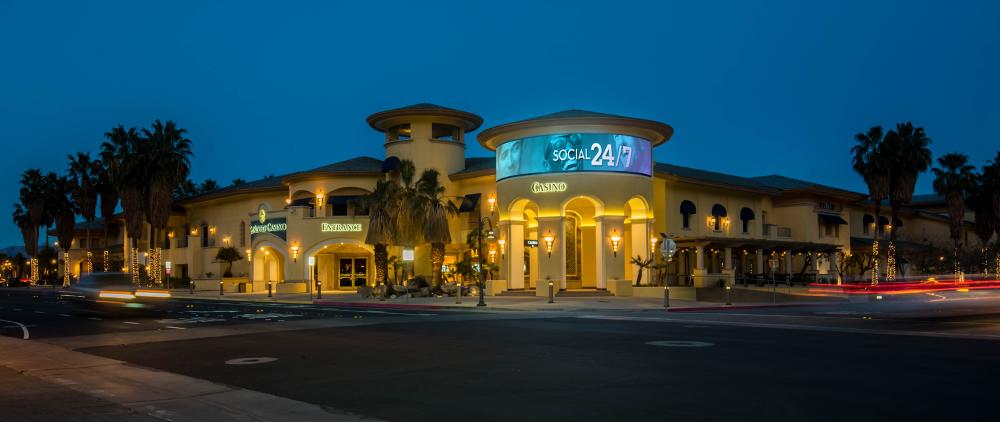
The Tribe opened Agua Caliente Casino Rancho Mirage, followed by locations in Palm Springs and Cathedral City. These ventures created jobs, generated revenue, and funded essential services, including education, healthcare, and housing assistance.
With each new development, the Tribe continued to strike a balance between economic progress and cultural stewardship, ensuring that the values and traditions of the Cahuilla people remained at the heart of their mission.
2020–Today: Honoring the Past, Building the Future
In recent years, the Tribe has turned its focus to cultural preservation and education. Near the original Spa Hotel site in downtown Palm Springs, the Agua Caliente Cultural Plaza is open. The new complex includes a museum, hot mineral spa, gardens, and spaces for storytelling, art, and community gatherings.
The Agua Caliente Cultural Plaza will honor the legacy of the Tribe's ancestors and the vision of the 1954 all-woman Tribal Council, whose leadership laid the groundwork for everything that followed.
